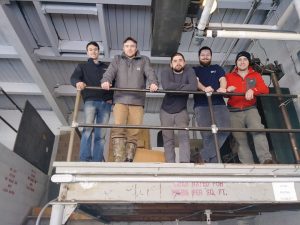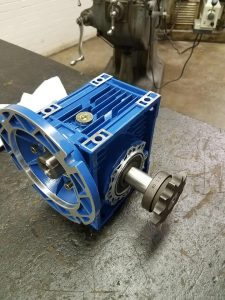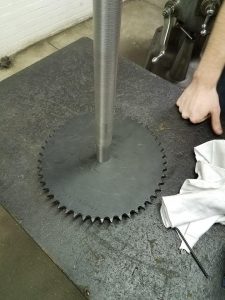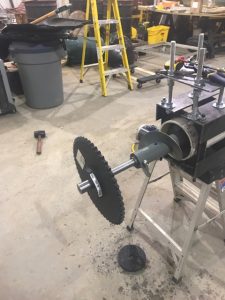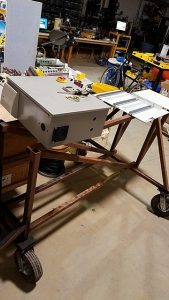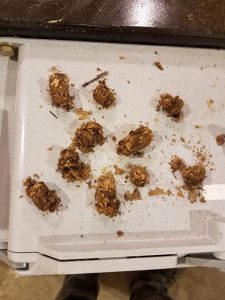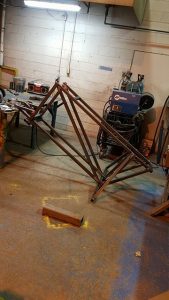2018 BIO PELLET MILL MODIFICATIONS
Group members:
Teagan Prince (far left):
Teagan is a 4th year Mechanical Engineering Technology student at the University of Maine. He was brought up in Veazie, Maine and aims to pursue a career in the automotive or pulp and paper industry after he graduates. In his free time, Teagan restores and modifies various cars and motorcycles. Teagan is also the president and founder of The University of Maine Car Club.
Andrew Michaud (middle left):
Andrew is a 4th year Mechanical Engineering Technology student from Presque Isle, Maine. He has interned the past three years in the quality side and as a project engineer at a Maine based high performance oriented strand board mill in Northern Maine and plans on moving back up to the county after graduation. He enjoys spending time in the woods and at the lake, riding his motorcycle, and performance diesel mechanics.
Jonathan Fortier (middle):
Jon is a 4th year Mechanical Engineering Technology student from Abbot, Maine. He has multiple years of experience in residential and light commercial plumbing and HVAC. Throughout his entire secondary and post-secondary education, he has spent a large portion of his time repairing and modifying a vast array of small engines and related components. Jon is extremely mechanically inclined, adjusts to new work settings well, and intends to use his skills in the HVAC industry in engineering sales or consultation.
Nate Gendreau (middle right):
Nate is a 4th year Mechanical Engineering Technology student. He is from Brewer, Maine. He aims to use his degree in either the automotive industry, or in the defense industry. He is into gaming and has an extremely large collection of Transformers. He works for the University of Maine Technology Research Center as a lab technician assistant.
Ryan Nicols (far right):
Ryan is a 4th year Mechanical Engineering Technology student from Mexico, Maine. Previously, he has interned with Turner Construction out of Boston and Fisher Engineering in Rockland. After graduating he would like to apply his skills in some sort of manufacturing setting. He enjoys hunting, fishing, and snowmobiling in his spare time.
Updates:
5/1/18
Here is the final video for the project: https://www.youtube.com/watch?v=1GzfYw_5q-w
In it, you can see the final product and the pellets made using the new automation system!
4/1-4/24
Nothing major has happened in the past couple of weeks. The project is slowly coming to a close and we are finalizing the smaller steps. As of 4/24, the auger system is 95% complete, barring an E-stop and some cosmetic things. We have tested the system with the pellet mill, with the supervision of Dr. Ellis, who has now seen the process first-hand, and it works extremely well. In the next week and a half we will be completing the project, and presenting on the whole thing!
3/21-3/30
As the project is ramping down, updates will decrease to a weekly basis. In this case, it covers 1 and a half weeks due to the same thing happening over that timeframe. The shaft and keys are finished! They now fit onto the auger system, in their respective places. Below are some pictures of the sprockets fitting onto the shaft:
3/12-3/20
During the week of spring break, not a whole lot got done. Between sickness and overall business, plus a snowstorm that wrecked the area, everyone was stuck. However, Jon was able to machine parts of two shafts that will be used in the auger system, and Nate was able to machine a pair of keys that will be used to hold the sprockets in place on the shafts. We were also able to grab a few things to use when putting the system together, including spring nuts, bolts for the spring nuts, and 3 30A fuses. The keys should be fitted into the shafts by sometime this week!
3/1/18 Part I
Today, we’ve decided to switch out the electrical box we had gotten previously from the TRC with a new one. The old one wasn’t quite deep enough to hold the VFD system. The new one is smaller length and width-wise, but is deeper and can accommodate the new system. It included a spare VFD system that was attached to the box, a transformer, a circuit breaker set, and some form of voltage dampener. Pictured below is the new box after Andrew was done messing with it:
2/27/18
Today the group successfully put the wheels on the auger frame, and made better pellets! They aren’t the best pellets, but they are the best we have gotten thus far. One step we did different was we added more moisture to the leaves, as well as wetting them while they were in the mill. Shown below are photos of the successful process, as well as the new wheels on the frame.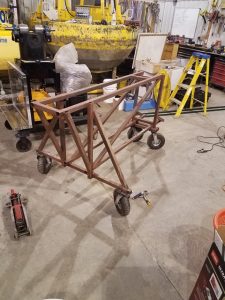
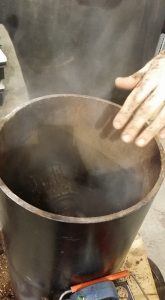
2/13/18
Today our auger holding system arrived! Yesterday, we bought an 8 inch wide, 10 foot long piece of schedule 40 PVC piping, which we picked up today. Here is the picture of it hanging out of Jon’s Toyota Highlander… fit like a hot dog in a hamburger bun.
It did arrive safely to the project room, however! Upon its arrival, we got the auger fitted into it, and mocked up into the frame using Teagan to judge the height. Since our auger is 6 inches wide, and the pipe is 8, that leaves 2 inches of room to play with, which we don’t want. One way we can possibly fix this is to cut a quarter of the pipe off, and clamp it together using straps. An alternative is to use U-bolts and a piece of sheet material (Jon has clear acrylic, and Teagan has aluminum sheets to use).
1/24/18 Cont.
Tonight, the group was working on mastering the art of pellet-making. So far, that hasn’t turned out the greatest. Here is the results:
In our experimentation with these “pellets” we found that the leaves used were way too dry, at around 5-6%. In a later experiment, we used wetter leaves, but those leaves clogged up the dyes on the pellet mill. We will continue experimenting to find the “sweet spot” for pellet-making
1/24/18
The auger has arrived! This album shows what the auger looks like, as well as how it will be attached to the frame shown earlier. It should be mentioned that the auger will not be attached by itself, as it it will have a housing around the outside of it to hold the contents in place.
Album: https://imgur.com/a/rqK0h
Note: the images shown in the album are too big to fit into wordpress apparently, so that is a workaround to still show the images
1/22/18
Apparently today the auger came… But it wasn’t actually the auger. A 10ft long, 2in wide piece of clear, floppy PVC piping doesn’t do anything for us! We are working on figuring out where the auger actually is, and we will go from there!
EDIT: According to our client, there was a mixup in transit. Our auger is currently on its way, and should be here within the next couple of days!
1/12-15/18
Our auger has been ordered! It should arrive in time for school to start. In the mean time, Teagan has been working to incorporate 208V power into the Marine Science Building. So far, he has been able to connect the power and get the mill working. This means we can start making pellets in the new building!
1/9/18
Today, part of our group was working on wiring up the DC motor for the smaller auger conveyor. That is not the easiest thing to do in the world! There were no wiring diagrams to work from, so we were working with just a multimeter and sheer dumb luck. After three hours, we finally got the whole thing working, but found another problem in the process: The motor turns too slowly to be of any use, at around 2 RPM. We are hoping to bump that up to 15-20RPM to have it be more effective.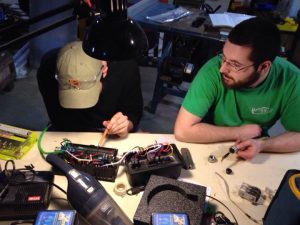
Pictured here is Jon and Nate working on that Variable Frequency Drive. Neither electrocuted themselves!
12/14/17
Today we met with our client to wrap up the project for the year. In this meeting, we presented our interim report and asked any questions we had about the project. As it turns out, we have been focusing on the wrong item to automate. We have been focusing on automating the moisture control of the project, but instead we are supposed to be automating the heating of the dyes. The moisture is just an extra part!
11/17-21/17
During this period of time, we started officially moving the non-mill parts, as well as small parts from the mill itself, into the Marine Science Warehouse. First to go were the hopper and the top of the chute, and then the auger assembly was to go last. We used Andrew’s truck to do all of this, as well as Nate’s Equinox and Teagan’s Saab. It took us this long because of team schedules, as well as finding a time where all of us could lift the auger assembly into the truck.
11/14/17
A lot of behind-the-scenes work has been going on with the mill, working on finalizing the project into its FINAL state, and getting our project moved to a different location. We have been given clearance to move the entire project into the Marine Science Building, near the ERS center. This site is better than our current setup, because we have a lot more room to work, as well as the facility being heated. As of today, all of the mill items have been moved except the mill itself!
11/8/17
Today we got the wheels on the mill! Took a bit of effort and a lot of moving, but the mill is mobile!
On a related note, we are also working on finalizing the mill design, working with our client on the matter. He wants to have a 6 foot span between the mill itself and the auger going up to it, to prevent fire hazards. This makes the mill a total of 14 feet tall, which is about the size of Decepticon Starscream. That’s very tall!
11/6/17
We have all the parts needed to get the wheels back onto the mill! The original tired just weren’t cut out for use on such a heavy piece of equipment. We found new tires in the project room (which STILL hasn’t been cleaned out), which are much more sturdy. We are currently in the process of switching the hubs on each tire to better fit the old setup, as the hubs on the new tires don’t match up.
10/27/17
On top of studying for the Design quiz today, our group also met with Nate’s supervisor, Keith Hodgins, to discuss the possibilities we have of using some of the equipment and parts that are all over the Technology Research Center, as well as the Pulp and Paper testing facility in Jenness Hall. At the TRC, we talked about possibly moving the mill to that facility. It has much more room, there is less cleanup involved, and any parts we could possibly need would be within walking distance. Really, the only con to this is having to move the mill from Crosby Hall to there. Thankfully, we have the means to load it into a truck and haul it over! Currently, the move is only tentative, but will be made clearer as time goes on and discussions are had between staff at the TRC.
10/25/17
Today was the due date for our Capstone Interim Report. Huge shout-out to everyone for being awesome sports through the whole thing!
10/20/17
Today, our group met and discussed possible designs we wanted to use for this mill. All 4 of us at the meeting has different designs, but all included relatively the same parts. Those include:
- Agitator to move the particulate around
- A hopper to load the particulate into
- An auger that moves the particulate from the agitator to the dyes
- Some sort of collection system, like a conveyor belt
We also met with our client, Stephen Abbadessa. We discussed all of these ideas with him, and he gave the OK on what he thought would work, and also what fit the project. We had taken some sturdy tires from the project room, which is still cluttered, and are working to inflate them and fit them onto the current wheel housing.
Ryan has also been working very hard on our interim report. Kudos to him!
10/2/17
Today we took a look at the space we are moving the Pellet Mill to. It is extremely cluttered and disorganized currently, but Professor Berube says it will be cleaned by the end of the week.
9/25/17
Today we split into three groups. One group was the webmaster seminar, where we learned about this website and how to create stuff. Another was the Lead Editor meeting, where they learned all the fun, small things about Microsoft Word. The last group looked at the interim reports, due October 25th, and what needs to be in them.
Webmaster: Nate Gendreau
Lead Editors: Ryan Nicols and Jon Fortier
9/11/17
Capstone Projects assigned. Our group is in the Bio-Pellet Mill Project, which is automating and optimizing a pre-existing pellet mill from last years Capstone Project
3/1/18 Part II
WE HAVE MADE PERMISSIBLE PELLETS! By proper, we mean that the pellets are whole and don’t crumble, as well as having the glossy sheen most industrial pellets have. They even survive a bounce off the floor! Attached are some videos of us making these pellets.

